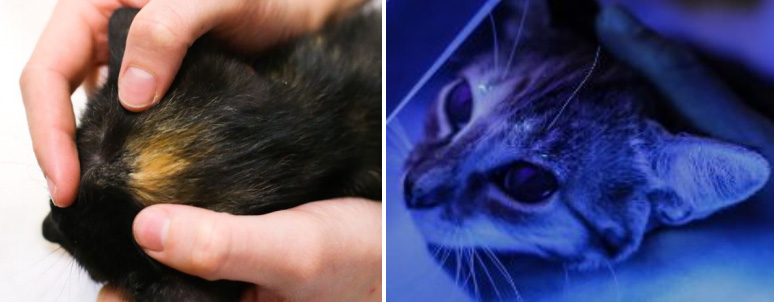This document defines APA! policy and procedure for screening cats for ringworm using a wood lamp upon intake, or suspect of fungal infection.

These policies and procedures apply to all staff and volunteers responsible for, or assisting with, APA! Cat Program and Cattery facilities. These documented procedures begin upon intake of all cats into APA! programs, as well as in the event of fungal signs in a feline currently under care of
APA! program, including within foster placements. Potential fungal infection symptoms include, but are not limited too, the following:
● Crusty Skin
● Lesions
● Missing Hair
● Itchiness or Skin Irritation
A cat can get ringworm directly through contact with an infected animal-or indirectly through contact with bedding, dishes, and other materials that have been contaminated with the skin cells or hairs of infected animals. Ringworm spores are notoriously hardy and can survive in the environment for more than a year. Ringworm is extremely contagious and can spread from cats to humans, children, and other pets.
APA! staff and volunteers to perform Woods Lamp Screenings for ringworm in accordance with these documented procedures.
It is the policy of APA! that ALL cats undergo ringworm screenings upon intake, or upon signs of fungal infections, prior to determining assigned location within APA! facilities and programs. Under no circumstances may a cat be placed within APA! catteries prior to such screening.
Cats who demonstrate signs of fungal infections, whether ringworm positive or negative upon Woods Lamp exam, should be brought to the attention of the Ringworm Manager or DVM. APA! is committed to controlling disease outbreaks and to providing essential care for all animals within APA! programs; staff and volunteers who are unsure whether a cat is Wood’s Lamp positive for ringworm or presenting signs of fungal infections are encouraged to consult the Ringworm Manager.
1. Preparation and Procedure
a. Ringworm screenings should be conducted with two people if possible; one person holding the cat while the other performs Woods Lamp examination on the cat.
b. Plug in the lamp and allow it warm up for 3-5 minutes.
c. Prepare to visually inspect the cat for any obvious signs of hair loss, damaged fur, skin flaking, redness, or crusty skin lesions. These areas should be examined very closely.
1 of 3 © 2019 Austin Pets Alive! All Rights Reserved
d. Once the lamp is warm, inspect animal using the light of the woods lamp, similar to fluorescent glow when items are exposed to a black light. Examinations begin at tail of the cat, over all areas of body, until reaching nose and mouth. Pay extra attention to areas of concern identified during visual inspection conducted previously.
e. Look for individual hairs to fluoresce an apple-green color.
f. The entire body must be examined as ringworm can present itself anywhere on the
body, including, ears, nose, tail, and under-body.
2. Tail and Body Inspection
a. While examining the tail and body, push the hair forward to find lesions that may be hidden beneath the hair. These may not be visible unless the hair is moved away from the skin. Be sure to check the cat’s torso.
3. Feet and Legs Inspection
a. Check between the cat’s toes and for any crust or build up on the claws.
b. Slowly examine the cat’s legs by brushing the hair upwards, ensuring to check under the arms as well.
4. Head Inspection
a. Carefully inspect the outside and inside of the cats ears.
b. Lastly inspect the areas close to the nose, under the cat’s eyes, and under the chin and neck.
Signs of ringworm but no fluoresce
● Not all ringworm lesions will fluoresce. If the skin is crusty or missing hair and is Wood’s Lamp negative, consult the Ringworm Manager or DVM who will determine whether the cat should be treated for ringworm/fungal infections.
● Extremely thick crusting of skin, or signs of itchiness on cat, constitutes reasoning for a skin scrape to test for mange.
● If you are unsure, consult with the Ringworm Manager.

